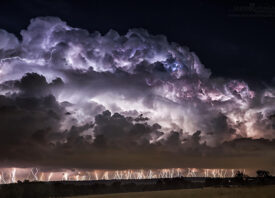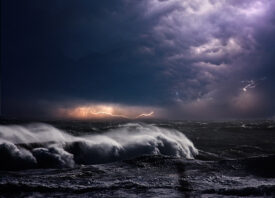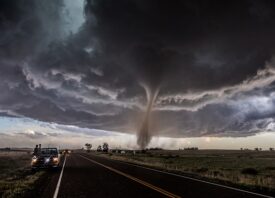Search this site
The Adventures of a Storm Chaser


“There have a been a few situations with lightning and tornadoes that were close enough that my ears popped from the change in air pressure,” the photographer and storm chaser Rob Darby tells me. “On my first storm chasing trip, a hailstone the size of a quarter hit my forehead and sent a shock through my skull.” Looking back now, he says that hailstone was relatively small, as strong supercells can result in hail the size of tennis balls.
Darby started photographing clouds when he was just eight or nine years old. “I used a Brownie camera that my father bought me,” he remembers. “One of my more vivid memories of that time was seeing a type of cloud that is somewhat unusual and rare…a lenticular cloud.” Looking back, he thinks he devoted two to three rolls of film to that single cloud. He grew up in the US Pacific Northwest, looking up at “dull grey skies, with an occasional break in the clouds.” Still, he longed for storms; in college, he pursued his passion for weather by majoring in Meteorology.
As an artist, Darby has turned time and again to the US Midwest, including the landscapes of Kansas. “Kansas is known for cornfields, farming, and, fortunately for me and other people who enjoy storms and storm chasing, large and sometimes violent thunderstorms call ‘supercells,’” he explains. “Kansas is uniquely positioned in a location where the ingredients needed to form supercells and tornados are found.
“Warm, moist air from the Gulf of Mexico streams northward and meets dry air from the desert southwest, along with cool air that drops into the area from the Pacific Ocean. These ingredients, when combined with rotation in the atmosphere, create the conditions required for the most violent storms.” He’s most likely to encounter a severe thunderstorm from April through June, but they can happen year-round.
While Darby admits that storm-chasing can be dangerous, he also makes safety his top priority. “Imagine driving down a country road, barely wide enough for one car, at 60 miles per hour, attempting to keep up with a storm that is moving as fast as you are,” he says. “Storm chasers and those of us who like to photograph the storms carry equipment that allows us to know the direction and speed of a storm, the possible conditions that are underneath it, and good navigation equipment so that we always have a way to get away from the storm should it become necessary.”
Darby describes his earlier work as “portraits of storms,” but his approach has shifted over time. “Unconsciously, perhaps, I found myself evolving to incorporate elements of the human landscapes into the images,” he tells us. “So, while my early work focused mostly on storm structure, now I find that I instinctively include elements of humanity in them: a decaying grain silo, a homestead, a small town, or even the juxtaposition of modern technology (a wind farm, for example) to provide more context to the scene.”
As he’s learned, the Midwest has countless hidden, human stories waiting to be discovered. “There are small towns that have been decimated by automation and globalization and may be in some stage of decay or death,” the artist explains. “Small family farms are often no longer able to compete with the larger companies, and so there are countless small towns that are relics now. They are not exactly ghost towns since residents may have stayed, but it is common to see decaying homesteads next to what appears to be a vibrant one.”
Darby also understands that these manmade structures, homes, and solos aren’t the only details that could change beyond recognition. We know that the climate crisis is affecting storms, but the artist reminds us that there’s still so much we don’t know about what those changes might look like. “Some theories suggest that supercells may become less common in Kansas, for example, due to the changes in the balance between moisture and wind speed and direction,” he says. “If the jet stream pushes farther north in response to a warming planet, the next generation may find that Canada becomes the new Kansas.
“Others argue that warmer sea surface temperatures will increase the available energy for storm formation. We are seeing this with hurricanes, for example, although the processes for these two types of weather are very different.” The photographs Darby makes today could be impossible to recreate in another half-century. “Extreme drought and flooding rains have already started to impact farmers and their ability to maintain their crops under the changing conditions,” he admits. “So perhaps a photographer 40 years from now will be photographing storms over warm-weather crops in Kansas (pineapples?) rather than over cornfields.”
Darby doesn’t have all the answers, but in the meantime, he’s content to look up at the sky and show us what he sees. He still thinks sometimes about that lenticular cloud he photographed at age eight or nine, using the Brownie camera his dad gave him. He doesn’t know where those two to three rolls of film wound up, but he wishes he did. Maybe someday he’ll find them again.













All images © Rob Darby



